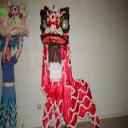Yahoo Answers is shutting down on May 4th, 2021 (Eastern Time) and beginning April 20th, 2021 (Eastern Time) the Yahoo Answers website will be in read-only mode. There will be no changes to other Yahoo properties or services, or your Yahoo account. You can find more information about the Yahoo Answers shutdown and how to download your data on this help page.
Trending News
Where you train, how much bunkai do you teach/learn of the real fighting applications of stance?
Is that even considered or taught where you train?
6 Answers
- pugpaws2Lv 75 years agoFavorite Answer
Good question Jim. I'll chip in. I teach applications for the stances. I see all stances not as static/still positions we sat in for a few seconds but as either techniques themselves or as part of a technique (as in the hands are involved and moving into the stance makes what I'm doing with my hands work the hands work) The simplest example I can thing of and have any chance of writing so people can understand it is the Hook stance seen in Naihanchi Kata. I do not see it as moving sideways at all. instead of crossing my legs to move sideways imagine an attacker standing in front of me and suddenly attacking with a kick. Moving sideways by crossing your legs would be to slow to work. I simply pivot on the balls of my feet turning my body 90 degrees, which would end in my legs being crossed the same as if I had stepped across into the hook stance. Yet as I pivot I sweep my arm or arms across my body with my hands held low. If timed correctly the pivot and arms low in front will deflect the incoming kick. by moving the leg nearest the attacker towards him, I can slide into him for a counter attack ro to take away his balance. In Naihanchi Shodan you cross legs to move into a horse or sumo stance and then strike out with the back of your right hand. In my application I evade and deflect his kick by pivoting. Then slide into him placing my foot behind his legs and the sweeping back hand strike can be a strike or my arm can push his upper body back causing him to trip over my leg. There are many other kata applications where a stance is a technique. Surely no good fighter actually stands still and fights while stationed in a stance.
- jwbulldogsLv 75 years ago
I train and teach bunkai all of the time. I still train with one of my instructors even though I have been training for over 30 years. We often go to other schools and teach their black belts bunkai as it isn't taught in their schools until we began doing it.
The applications of stance is also taught. Stances are the beginning or end of a technique. It can be a strikes, a throw, a sweep. One I learned recently was stance and create a short in energy flow like a sort. I was skeptical until it worked for me. It was no longer theory when I learned how to apply it. We were studying bunkai. The application was taken from tai chi. I don't often share these things online but it is safe to practice. We allowed a person to put us in a joint lock. Then while standing in a cat stance we stomp the heel down. It doesn't have to be a hard stomp. It creates a a momentary short. You do not feel the pain of the lock. then that gives you a split second to perform the escape. In the class the escape was taught first. the the question was asked what happens if you don't get out of the lock before it is really locked in. This was a set up question. Most of the time we think once it is locked in it is over. But creating this short give you the time to use you escape technique. When I was taught to put the heel down in a cat stance it was taught that you do this to step. But in Chinese styles it had another purpose that I hadn't been taught.
Since pugspaw mentioned niahanchi shodan I share a little of it as taught by Nagamine the founder of Matsubayashi ryu. The crossed hands symbolizes that you were grabbed and you do a wrist lock to escape. The wrist lock used here is nikyo. Then we kick the inside thigh out to cause the attacker to bend over and take their balance. Then we can grab the head and twist and throw them. This leaves us in the horse stand and "chambered". It wasn't a chamber as taught. It was a throw using the head.
- LiondancerLv 75 years ago
Every class. What is the use and purpose of learning movements if you do not know what to do with them? It is also difficult for students sometimes to get the timing of a movement right if they do not know how it is applied. If you do not practice a movement correctly then there is no purpose in doing it. Practice makes permanent, not perfect. Perfect permanent practice makes perfect. With other words you have to practice correctly too.
Everything comes from the stances. I sometimes only watch my students' feet and can tell exactly if their hand technique is any good without having to see the hand technique, I only need to see the feet. Try it sometimes. It's really interesting.
To your comment your stance as a technique. I consider moving as part of my technique. Who is going to just stand there and punch? I move in or off to the side at different angles. If I get it right I'll end up on my opponent's foot and then punch you so he can't step back and trip. My stepping in any stance should always be in a manner that it will compromise my opponent in some way so my strike is much more efficient. Just standing there and beating someone, takes way too much energy. I am getting too old for that.
And as far as this being taught where I train. It is not. My first teacher taught it to me long ago and I have built on that and I teach it to my students but none of the other schools I train in puts much emphasis on footwork. They don't even know the names for the different stances.
- 5 years ago
More than probably what you think but I also relate it then to practical examples that people can generally relate to better in their thinking which helps them understand how this all is related. Then it just becomes a matter of them learning how to do that and that tends to be pretty self-motivating.
A good example of this is a reverse punch and hitting the heavy bag. At full extension I can really hit that bag hard when going from a fighting stance to a forward stance, setting down to transfer the power better, using my hips, and then popping back up into a fighting stance and doing something else or moving off at an angle. (Fighters and people are usually surprised by how hard I can hit the bag and more than one opponent has commented before about how hard I can hit as well when I have fought them.)
Then after demonstrating the above I will show people a rooted stance where I am closer to the bag and can't get full extension. Then of course I have to shorten my punch so as to not push it along with drawing power up from my legs along with using my hips and I can hit that bag almost as hard as when further away and they are really surprised by that even more. Demonstrating things along with using examples like a boxer setting down on his punches, or a person lifting something heavy using their legs and hips to lift it, or a baseball player up to bat at the plate or a golfer teeing off are all good examples that people can generally relate to better to help them understand some aspects of martial arts and the importance of them like what you are asking about.
In closing some of those power-lifters and weight lifters that used to work out when I did at the same place would sometimes ask me something like what you are asking. Then I would take their hand and apply a sword grip of their hand and wrist and turn it pinching their ulnar nerve a little. They then would of course tighten up or flex and then that would relief that pressure some. But when I would either step forward or backwards (depending on the distance between us) and using my hips and entire upper body by turning and the power of that then it would not matter if they were flexed or not. They were going over sideways on the floor and spinning with their head at my feet and me holding that hand still.
What you are asking is one of the things that helps make martial arts work. Sadly is generally not taught as well or as much as what it should be and so people then often fail to understand things and also it then waters down their ability and effectiveness as well is what I have generally found.
- How do you think about the answers? You can sign in to vote the answer.
- Anonymous5 years ago
Stretching and stance training is first every single class. Next reviewed is power generation through proper stances while linking that power to related techniques. Continuing with exercises from static horse stance then moving up and down the floor or varied directions while always using correct stances. Next is prearranged fighting techniques with a partner using stances to block, check, plow, or seal the opponent. Last is opening the prearranged attack to include random techniques including grabs to help simulate real world fights again using stances as part of the defense. Always using stances because they the root of any martial art.
If you are looking for specific techniques that would entail too much to write here and a lot would be lost in translation without video.
- Riki3Lv 55 years ago
In my own personal training, everything comes from the stance, for me everything starts from a good foundation, i believe if you dont have this right the rest that builds on from the foundation isnt going to be right, my teacher was strong on this from day one, shifting, posture, stance alignment all play a part in how effective the upper technique is going to be. When i mention strong stance im not talking ridged hard stances im talking strong powerful flowing stances that carry with ease, that complement the upper part of the body whether it be freehand or holding weaponry, from my Kempo to Chuan Fa to Tai Chi or Mau Rakau all very different but all build off from stance.
Even when ive taught applications il get students to adjust height or get them to tweak their feet a fraction off alignment to show how much can be affected by something that can be easily overlooked.
Great question and answers !!!






